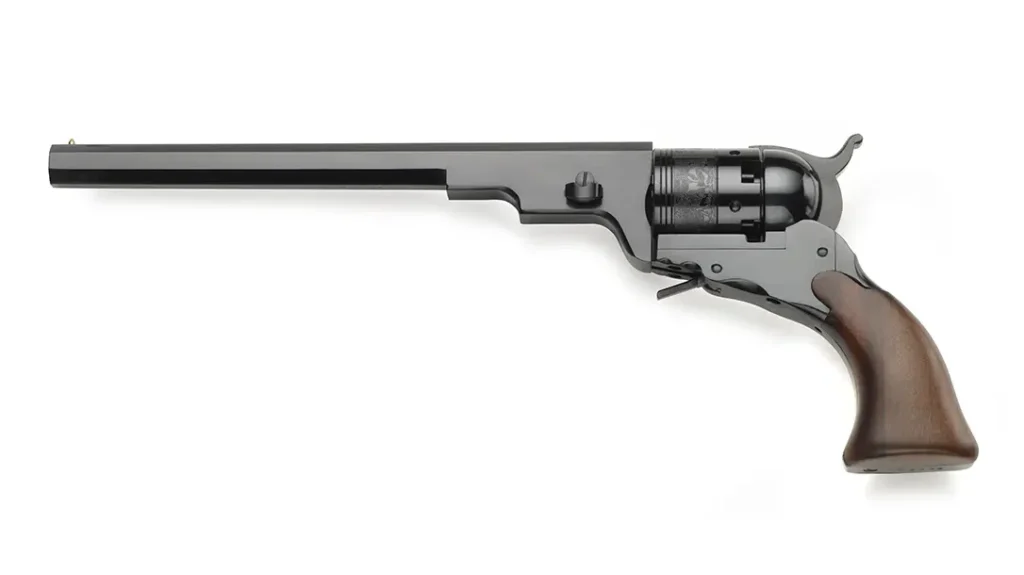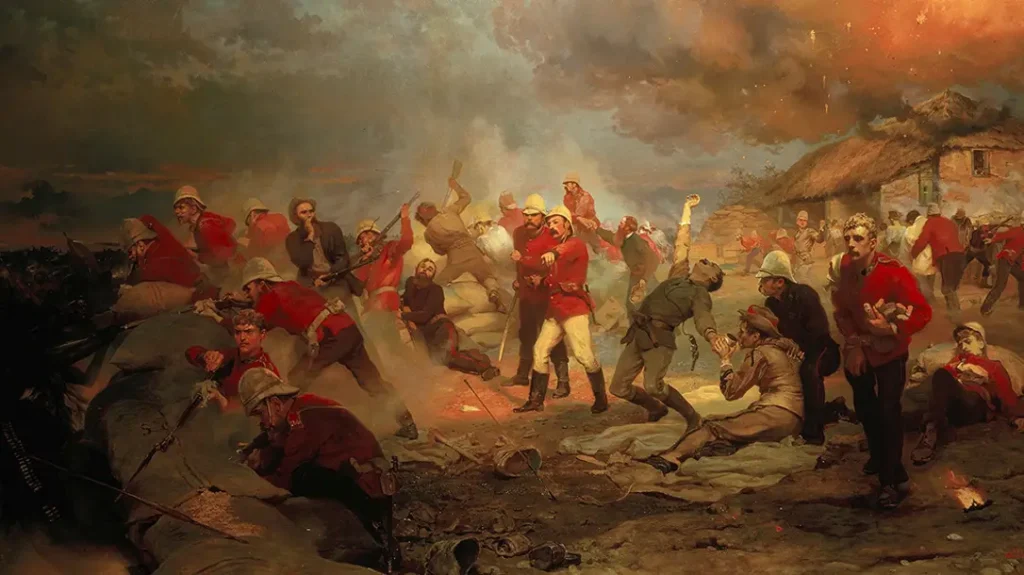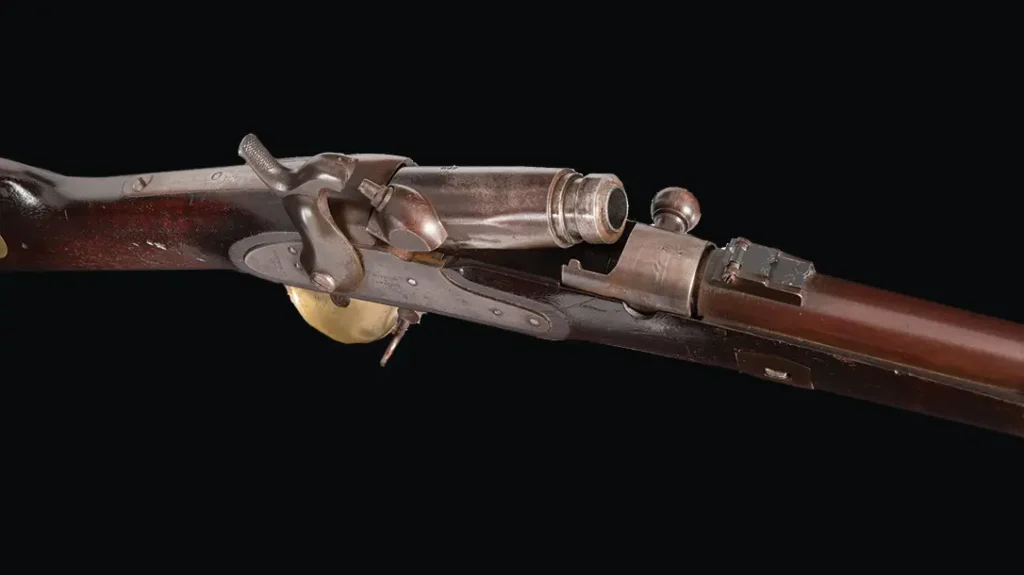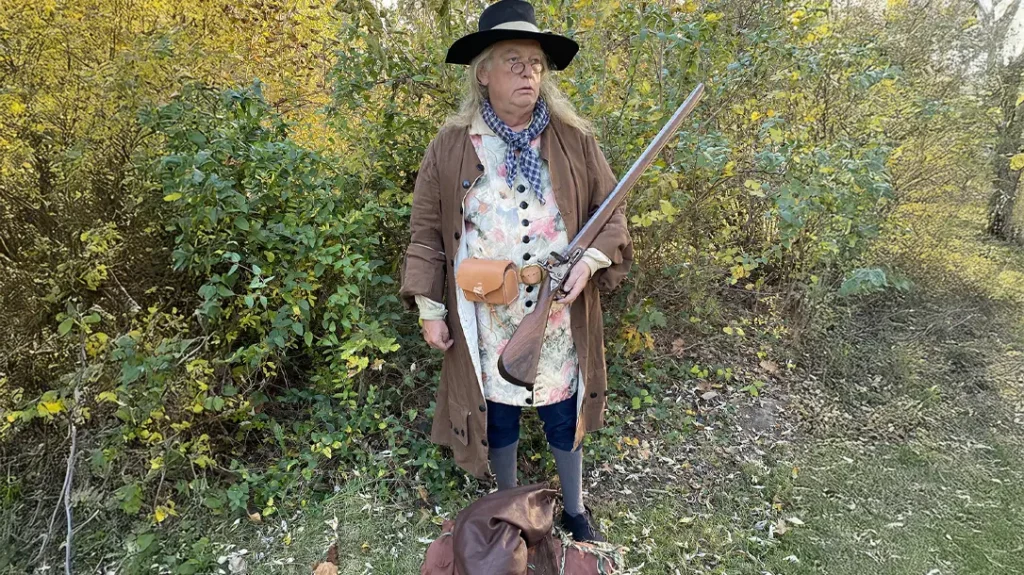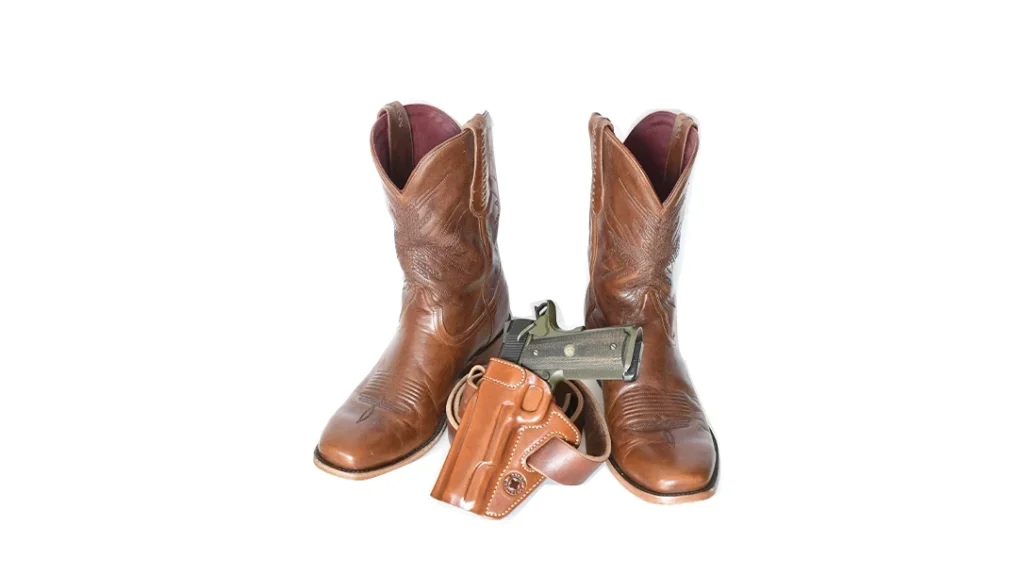This post was originally published on this site.
The Colt Paterson is where the American revolver story really begins. Patented in 1836 and built by the Patent Arms Manufacturing Company in Paterson, New Jersey, it was Samuel Colt’s first commercial success and failure at the same time. Success, because the mechanism worked and showed the world what a practical repeating handgun could do. Failure, because sales were slow and the company went bankrupt in 1842. Still, the Paterson set the pattern for almost every Colt that followed and helped change how Americans fought on horseback and on foot.
The Colt Paterson Revolver – The Legend Begins
Colt’s idea came from simple clockwork. On a sea voyage as a young man, he studied the ratchet and pawl systems around him and carved a wooden model of a rotating cylinder pistol. The concept was a single action. Cock the hammer, and the internal hand turned the cylinder to bring a fresh chamber in line with the barrel. Pull the trigger, and the pistol fired a percussion cap and ball. This cycle, repeated five times, delivered a power and tempo that a single-shot pistol could not match.
The Paterson family produced several models, ranging from tiny pocket guns to the No. 5 Holster Model, more commonly known as the Texas Paterson. Most were five-shot guns in small bores, such as .28 and .31, with the Holster model moving up to .36. Early guns had no loading lever. To charge them, the shooter removed a wedge, slipped off the barrel, pulled the cylinder, and loaded powder and ball on the bench with a separate tool. It was a careful process, but it meant a compact profile. Later Holster models added a fixed rammer under the barrel, which made field loading faster and more practical.
Advertisement — Continue Reading Below
Colt Signature Designs
A few design choices became Colt signatures. The frame was open on top, with the barrel pinned to an arbor and held by a transverse wedge. The trigger folded flush with the frame and popped out only when the hammer was cocked. That kept the gun from snagging and gave the profile a clean, streamlined look. The rear sight consisted of a notch in the hammer, while the front sight was a small blade on the barrel. The cylinder carried tiny safety pins between the nipples, allowing the hammer to rest between charged chambers. For a rider on rough ground, that mattered.
Mechanically, the Paterson was interesting. The hand and ratchet system rotated the cylinder as the hammer moved. A spring-loaded bolt engaged notches on the cylinder to lock it in battery at full cock. Tolerances had to be right, and early production quality varied. Caps could fall into the works, and fouling would slow things down. Even so, for its time, the gun ran well enough to change the course of a fight. A capable user could fire five aimed shots, recock, and deliver a second or third string without the stop-and-reload pause that defined single-shot pistols.
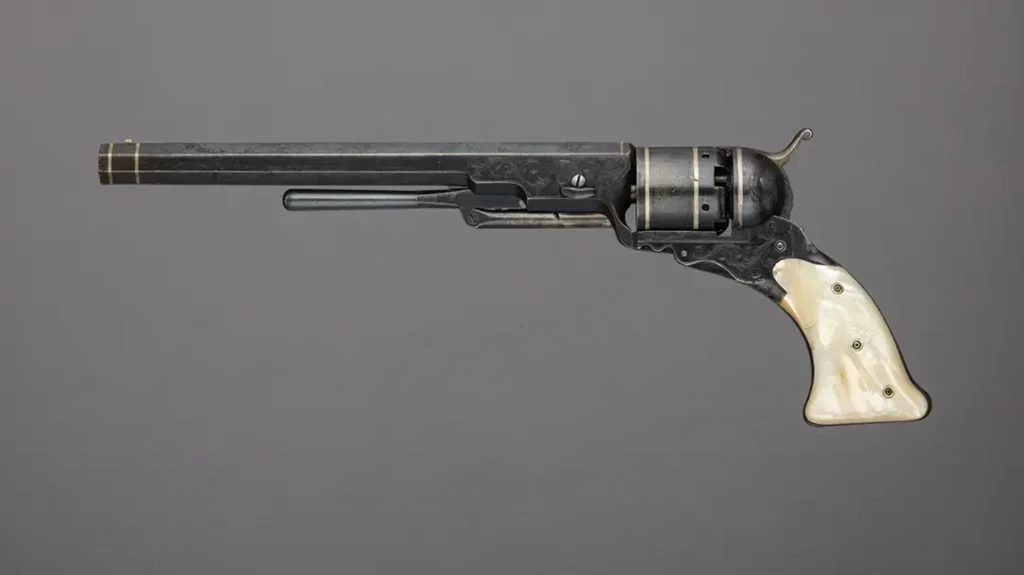
Advertisement — Continue Reading Below
Texas Patersons
The gun’s real test came in Texas. The Republic of Texas and its Rangers saw the value of a repeating pistol in skirmishes. Orders from Texas, including those from the Texas Navy and militia, provided Colt with a lifeline and proof of concept. Captain John Coffee Hays and his Rangers used Patersons with speed and surprise. At the 1844 fight on Walker’s Creek, revolvers helped a small mounted force defeat a larger group by keeping the fight at close range. The lesson was clear. A brace of revolvers in practiced hands let a rider deliver sustained fire without dismounting.
Despite that hard-won reputation, the Paterson could not keep the company afloat. The guns were costly to make, and government contracts did not arrive in time. In 1842, Patent Arms closed its doors. The story could have ended there, but it did not. The field experience in Texas led Captain Samuel Walker to propose a bigger, simpler, and stronger revolver for military use. Colt partnered with Eli Whitney Jr. to build it, and the 1847 Walker revolver revived Colt’s fortunes. The Walkers’ bones are pure Paterson, only heavier and tuned for war.
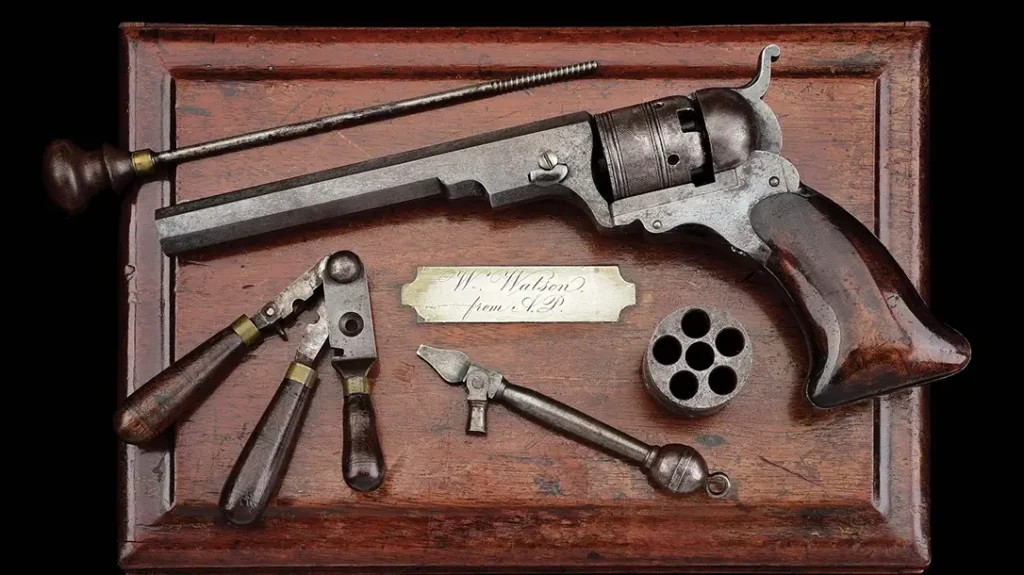
Advertisement — Continue Reading Below
Striking Design
As an object, the Paterson remains a striking one. The lines are slim. The cylinder is long for its bore. The grip angles feel natural. Some variants had longer barrels for holster carry on horseback, while others were shorter and designed for a coat pocket. Beyond pistols, Colt produced Paterson revolving carbines and shotguns, all of which used the same rotating cylinder concept. Those long guns had their own issues with muzzle blast cutting the forearm and cylinder gap flash, which the era’s materials did not handle well, but they show how flexible the mechanism was.
From a modern perspective, the Patersons’ shortcomings are readily apparent. The absence of a top strap meant a frame that could stretch under heavy use. Fine parts demanded careful maintenance. Early loading without a lever was slow. Percussion caps and loose powder required patience and good tools. Yet none of those points erases what the gun accomplished. It took the repeating pistol from theory to practice, showing both soldiers and civilians that five ready shots could be carried in one hand.
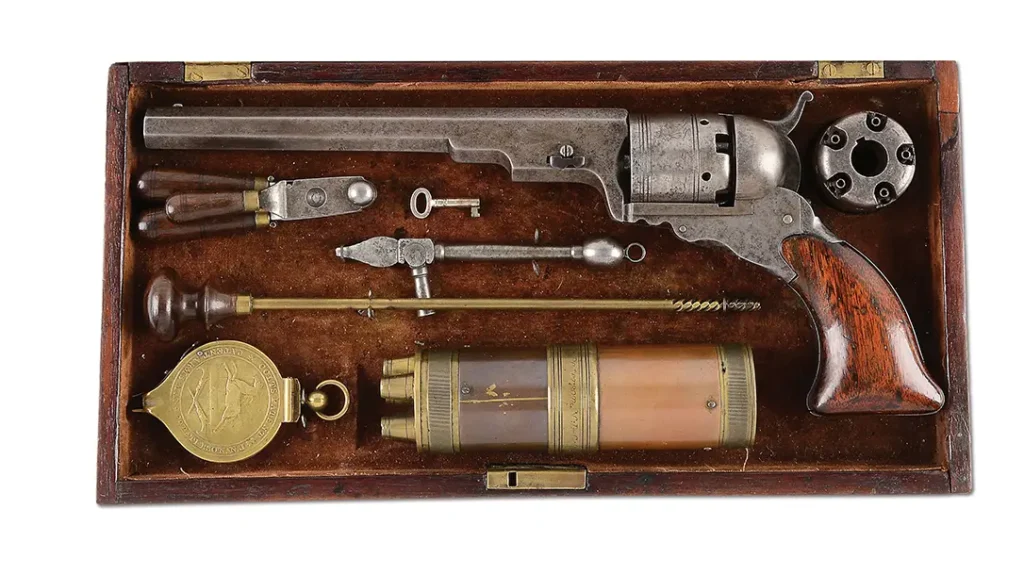
Advertisement — Continue Reading Below
Collectors Item
Collectors and historians track several variations, markings, and incremental improvements across production. Barrels, grips, and cylinder scenes differ by batch. The famous Texas Paterson, with its longer barrel and later loading lever, brings the highest attention for obvious reasons. Recently, a Paterson sold for almost a million dollars at auction. Even so, the smaller pocket models tell the full story just as well. They were personal guns for travelers, traders, and anyone who wanted more than a single chance if trouble started.
The Colt Paterson Revolver
The Colt Paterson did not win its era. It prepared the ground for what was to come. The mechanism, the wedge-retained barrel, the open frame, the single-action cycle, and the idea of a practical repeating sidearm flowed directly into the Walkers, Dragoons, and the 1851 Navy and 1860 Army that followed. Those later guns earned the fame. The Paterson earned the blueprint. For students of design and history, that is more than enough to give it a secure place in the American firearms story.
The post The Colt Paterson Revolver – The Beginning of American Revolvers appeared first on Athlon Outdoors Exclusive Firearm Updates, Reviews & News.
Advertisement — Continue Reading Below
